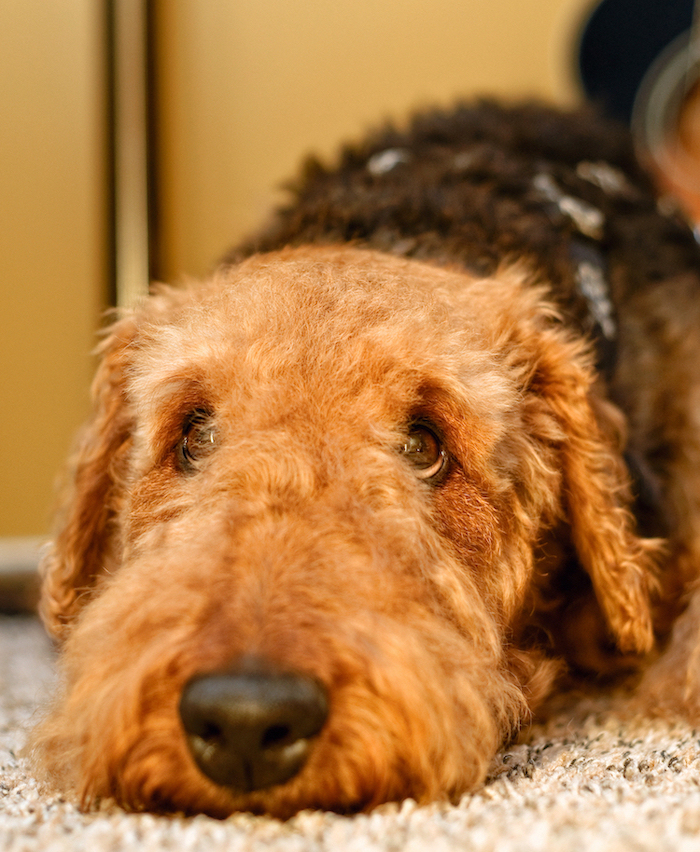No human wants to think about their dog getting a serious illness like kidney disease—but learning how to spot the ailment, how it’s treated, and what to expect at the vet can help you put your pup in the best position to stay as healthy as possible for as long as possible.
What is kidney disease?
In dogs, as in humans, the kidneys have many jobs—including filtering waste out of the blood, helping to keep a body’s mineral levels within the right range, and producing urine. In dogs with kidney disease—also known as kidney failure or renal failure—these organs don’t work the way they should. This can happen because the kidneys slowly “wear out,” as in chronic kidney disease, or because of an individual event, which is the case in acute kidney injury.
What are the signs of kidney disease?
Once it’s been lost, kidney tissue can’t regrow—but even as the kidneys undergo normal wear throughout a dog’s life, they can maintain normal function for a long time. This is good in that it means a dog won’t suffer catastrophe from a small amount of wear, but it also means that most dogs’ kidneys have sustained considerable damage before there is obvious evidence that they’re ill.
Signs of kidney disease in a dog can vary, but may include:
- Drinking more water than usual
- Frequent urination (usually this and the increased thirst are earlier signs)
- Loss of appetite
- Weight loss
- Lethargy
- Very bad breath
- Vomiting
- Diarrhea
If you notice any of these signs that your dog is not feeling well, call a veterinarian as soon as possible—early diagnosis can help a lot in treating kidney disease.
How do veterinarians diagnose kidney disease?
Veterinarians can diagnose kidney issues through urine and blood tests. Many of these tests are used to look for levels of certain waste products that rise when the kidneys don’t work properly. Your veterinary care team can guide you about which tests are right for your dog, and may recommend routine monitoring of many blood and urine values as they age to help catch early changes and understand your dog’s baseline. This can be beneficial for treatment (see below), as dogs with kidney disease have a better prognosis if the condition hasn’t had as much time to progress.
A vet can also look for underlying conditions that may cause kidney issues, including Lyme disease, leptospirosis, Addison’s disease, and the ingestion of certain toxins. If you know that your dog has a kidney problem, and you’re not sure of the cause, it’s a good idea to do everything you can to figure it out. Some sudden cases of kidney failure can be resolved if caught early—but the chronic version can only be managed.
How is kidney disease treated?
As noted above, some cases of acute kidney injury—those brought on by causes like an infection, a poison, a drug side effect, or an accident—can be resolved if they’re caught early enough and treated.
Unfortunately, chronic kidney disease cannot be cured. However, treatment can help some afflicted dogs live happily for years. Vets take different approaches depending on an individual dog’s circumstances.
As noted above, early diagnosis helps—if there’s been less damage to a dog’s kidneys, they have a better chance of living longer and with a better quality of life.
If there’s an underlying cause of the kidney disease—such as an infection—the vet will need to address that to avoid any further damage.
Treatment for kidney disease will vary based on the stage of illness at diagnosis and how well the dog is doing. In some cases, this initial treatment may include hospitalization and IV fluids to help flush out toxins and maintain hydration.
Once the disease has been managed following the initial diagnosis, your veterinary care team may discuss many other possibilities for ongoing treatment, including medications and dietary changes. The specific needs of each dog will vary, so you should discuss your dog’s options thoroughly with a trusted veterinarian to make sure they are getting the best care possible.These conversations can be frequent in some cases, and regular monitoring and adjustments are part of staying on top of the disease’s progression. Your veterinary care team can guide you through the right frequency of these rechecks and assessments, and what they entail, based on the needs of your dog.
Because loss of appetite is common in dogs with chronic kidney disease, it can be challenging to get dogs with the condition to eat enough food. Talk to your veterinary care team to find the right options for what to feed your dog, and how to make it as palatable as possible. This can sometimes include medication to help with their appetite or symptoms that might be impacting it.

How can I protect my dog from kidney disease?
There’s no guarantee that a dog will be able to avoid kidney disease, but you can help shield them from certain causes of the ailment. Because kidney disease can be caused by toxins and injury, keeping your dog away from poisons and dangerous situations will reduce their chances of the illness. Some foods, like grapes and raisins, can damage dogs’ kidneys, so take care to keep unsafe ingredients where your pup can’t get them.
Infectious diseases like leptospirosis can cause kidney damage—but there are steps you can take to help reduce your dog’s chances of contracting lepto, including vaccination and avoiding areas with rats.
Chronic kidney disease is much more common in older dogs than younger ones, so be especially vigilant about watching for signs of the ailment as your dog ages. As with many issues, knowing what’s “normal” for your dog and paying attention to any unexplained changes is the best way to act quickly should your pup show signs of kidney disease.










